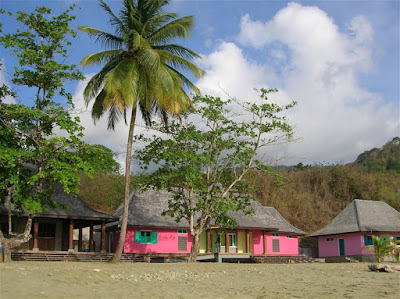Tiny,
peaceful Tobago was once the scene of one of the bloodiest sea battles ever
fought – one that saw 20 ships destroyed and sunk to the bottom of the sea. The
year was 1677, and over 2,000 people, including 250 French and Dutch women and
children and 300 African slaves, met horrific deaths in the waters.
When the
British admiral Sir John Harman encountered the combined fleets of France and
Holland which had rendezvoused off a bay then called Anse Erasme or Rash House
Bay, now known as Bloody Bay on the north-west or leeward side of the island.
It is said that the British defeated them with such great slaughter that the
sea ran red in the golden sunset, the cannon booming into the night. Today,
giant immortelle trees bloom a brilliant scarlet red on the mountains above
Bloody Bay.
The
island was called “Bellaforma” by Christopher Columbus when he came upon it in
1498, because it was so beautiful. It came to be highly prized and changed
hands more than 30 times as several European nations fought over the island. But
little is said or known about the human toll of these military dramas.
The
early Dutch maps give it the name 'Rasphuys Bay'. Rasphuis, according to
English historian Simon Schama, was a 17th century workhouse
in Amsterdam where brazilwood was powdered to produce dye. The timber was
rasped by convicts, and hence the name 'rasp house'. Indeed, until 50 years ago
Parlatuvier, the village in the next bay, still had a sawmill and one of the
most important dyewoods from the district, called redwood, also known as
'bloodwood', for it red stained look. Was Bloody Bay a similar user of '
bloodwood'.
We will
make you Fishers of Men - A catch of biblical proportions. Early April 2001 the
Bloody Bay seine fishermen hauled in a record catch, probably Tobago's largest
in living history. They ran out of vans to take the fish to Scarborough market.
The villagers of Bloody Bay had their fill, one lady was carrying so much that
she fell over. A number of local buses detoured to the beach where the drivers
and passengers all helped themselves to the catch. Hugh quantities were salted
for later use. Still many were buried to prevent pollution. Thanks was given to
God for his blessings.

This is
one of these places in Tobago where you don’t need to be a photographer. Any
picture you take here is going to look good. This beach has everything
including a nice surrounding with a river entering the sea, rocks, and an
unspoilt background and so on. It’s a bit of a drive to reach located between
Parlatuvier and Charlottesville, but even the trip itself is – as with most –
already worth going. You can take the route over the north and the south side
of Tobago to reach Bloody Bay. If you take the south side you can either make a
circle through Charlottesville or make a short cut through the rainforest,
which leads you straight to Bloody Bay.
Another fun fact !!!
Although little is said or known about the human toll of these military dramas. This
will soon change, when the incredible story of two gut-wrenching battles comes
to light in a movie docudrama called Tobago 1677. The team behind the local
production company Oceans Discovery Tobago Ltd, German filmmaker Rick Haupt and
photographer Sylvia Krueger, are architects of an ambitious, technically
challenging movie that will raise the seventeenth-century ghosts from their
watery grave and potentially put Tobago on the map for its unique archaeological
heritage.
Once
your done dipping in the calm waters there is the lovely and newly built beach facilities,
all painted in the beautiful vibrant colors, if you’d rather a fun filled
family day, where you fire up the grill and load the coolers with your favorite
drinks, bloody bay is the beach for you.




































